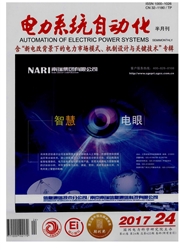

 中文摘要:
中文摘要:
提出在灾害导致城市配电网大面积停电时,对停电区域进行区域划分,然后在各区域利用移动应急电源组成应急微电网对其中的重要负荷供电。针对该应急微电网,所提出的分散控制策略采用分层控制思想,一次控制采用传统的线性下垂控制;二次控制通过基于本地信息的反馈控制,无需中央控制器和通信网络即可实现系统频率、电压的二次调节,使其维持在允许的范围内。二次控制中低通滤波器的设计,实现一次、二次控制的动态解耦,减弱二者的内部联系。此外,该控制策略能够协调移动应急电源按其容量等比例分配有功负荷。
 英文摘要:
英文摘要:
The blackout area is partitioned into small areas when large area blackout occurs because of natural disasters in an urban distribution system. An emergency microgrid consisting of mobile emergency power sources is used to supply important loads in each area. The hierarchical control structure is utilized in the emergency microgrid. The primary control is the conventional linear droop control while the secondary control can achieve frequency and voltage restoration by feedback control based on local information. Without the central controller or communication system, the good dynamic characteristic of primary linear droop control is maintained. A low pass filter is designed in the secondary control to decouple the dynamic characteristics of the primary control and secondary control into different time scales. In addition, the active loads are dispatched based on the apparent power of the sources. This work is supported by National Key Research and Development Program of China (No. 2016YFB0900605) and National Natural Science Foundation of China (No. 51577168).
 同期刊论文项目
同期刊论文项目
 同项目期刊论文
同项目期刊论文
 期刊信息
期刊信息
